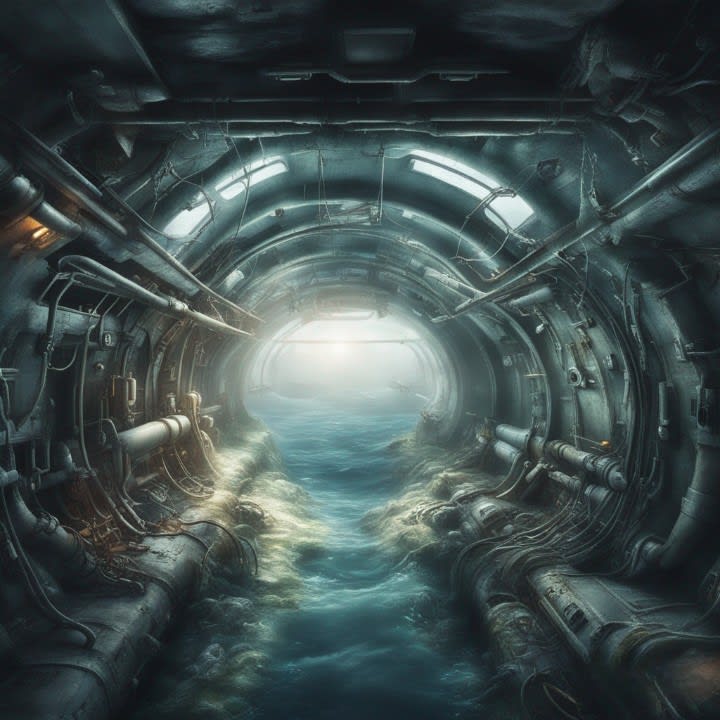Why did the submarine Titan implode, and how did the crew survive?
Diving deep into the ocean in a submarine is a risky adventure. You could face many dangers, such as running out of oxygen, getting poisoned, or being crushed by the water pressure. If your submarine starts to sink and implode, you will die a terrible death. The only consolation is that it will be very quick. Your body will be reduced to a pulp of broken bones and flesh as it falls to the ocean floor. In this amazing new story, we will tell you what causes a submarine to implode and what happens to the people inside when everything goes wrong! ⚓😵🌊

Death by Submarine: How Implosions Instantly Annihilate Crews
Submarines represent incredible feats of engineering that allow humans to explore the ocean depths. But when mechanical failures strike these vessels deep below the waves, the results are often catastrophic implosions killing all aboard.
This story will look at how submarines work, the immense pressures of the deep, and notorious disasters like the Thresher, San Juan, and Titan that saw crews perish in terrifying implosions. We’ll also examine what happens to the fragile human body during these underwater calamities.

How Submarines Maintain Depth
Submarines maneuver up and down using ballast tanks that fill with air or water to control buoyancy. To dive, tanks flood with water, increasing weight. To surface, compressed air displaces the water, making the sub buoyant again.
Neutral buoyancy can also be achieved by balancing air and water to remain at a stable depth. This involves a complex interplay of systems to sustain crew survival far below the waves.
Extreme Undersea Pressures
The ocean applies immense force on submerged vessels. At a depth of just 10 meters, pressure equals double the atmosphere at sea level. By 100 meters down, pressure reaches over 40 psi.
As depth increases, water weight crushing down escalates. Modern submarines can withstand over 400 psi in their hulls, though catastrophic failures do occur. Humans face a much lower pressure threshold before bones and organs rupture.
"At around 100 feet or 30.5 meters, you have just over 3 atm or 44 psi of pressure pushing against your body," explained one naval physician. "This would be like having 4 1-gallon-sized tins of paint pushing on every square inch of your body."
While specially-adapted sea life can dive deep, human physiology has strict depth limits. Internal vessel pressure must remain significantly below external water pressure to prevent deadly implosions.

Causes of Submarine Implosions
A submersible implodes when hull integrity fails, causing external pressure to crush inward violently. This can result from:
- Accidental flooding - Water breaching the hull causes sinking below crush depth.
- Mechanical failures - Ballast system breakdowns prevent surfacing during emergencies.
- Design flaws - Experimental or cheap construction materials crack under stress.
Sudden pressure equilibrium shreds occupants and collapses the hull like a soda can. Implosions occur almost instantly, giving no chance for escape.
The Terrifying USS Thresher Disaster
In 1963, the nuclear submarine USS Thresher sank during deep diving trials, killing 129 aboard. At test depth, a pipe burst causing flooding. Unable to surface, the crippled Thresher passed below 1,300 feet.
"At 9:13 a.m., the naval ship on the surface detected a high-energy, low-frequency noise. This was the sound of the U.S.S. Thresher imploding," recounted one historian.
Freezing air lines likely prevented blowing ballast tanks to ascend. The Thresher succumbed around 2,400 feet down, subjecting the hull to over 1,000 psi of unrelenting pressure. Death for the trapped crew was mercifully instantaneous.

The Mysterious Loss of the ARA San Juan
In November 2017, the Argentine submarine ARA San Juan vanished in the Atlantic with 44 souls aboard. An extensive search only uncovered the crushed wreckage a year later at a depth of 2,967 feet.
The San Juan evidently suffered a catastrophic failure that prevented surfacing. When its hull imploded under 1,338 psi of water pressure, the crew perished immediately. The speed and violence of the implosion left only scattered debris on the seafloor.
Titan Submersible - A Modern Tragedy
In 2022, the passenger submersible Titan sank after an apparent hull collapse during a dive, killing 5. The craft was descending to view the Titanic wreckage over 12,000 feet down.
Experts believe flaws in the carbon fiber hull allowed an implosion at immense depth. The Titan's groundbreaking material possibly failed under stresses beyond 5,600 psi. Once again, the crew likely felt no pain as instant destruction tore through the stricken craft.

The Horror of Human Bodies Under Pressure
While death comes mercifully quick in submarine implosions, the horrific aftermath is telling. Autopsies of recovered bodies show fluid-filled lungs, ruptured internal organs, and pulverized bones.
The rapid pressure spike violently crushes every cavity and vaporizes tissue. While less painful than drowning or slow asphyxiation, the catastrophic mutilation leaves little for loved ones to mourn.
These grisly human consequences illuminate the unforgiving nature of the deep. Man's ingenuity opens the ocean's frontier, but risks remain ever-present. Yet intrepid explorers will continue braving the depths, advancing technology and science to unravel the sea's timeless mysteries.
📝 SOURCES
- https://pastebin.com/JKhsMutb.
- Disclaimer: Images apart from the title image were generated with Bing AI, we always want to entrust our readers are not deceived.
About the Creator
Reader insights
Nice work
Very well written. Keep up the good work!
Top insight
Excellent storytelling
Original narrative & well developed characters






Comments
There are no comments for this story
Be the first to respond and start the conversation.